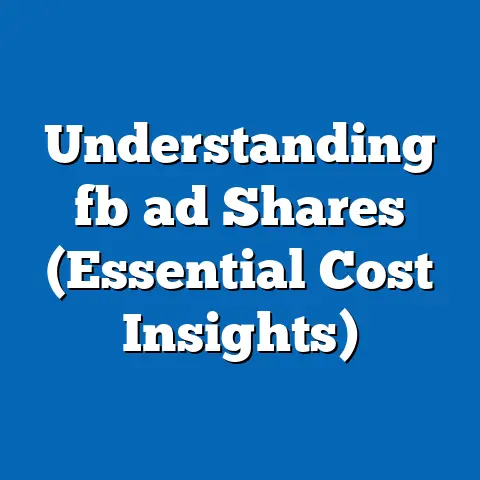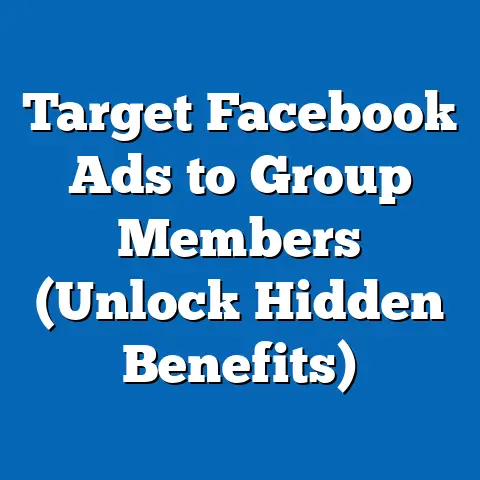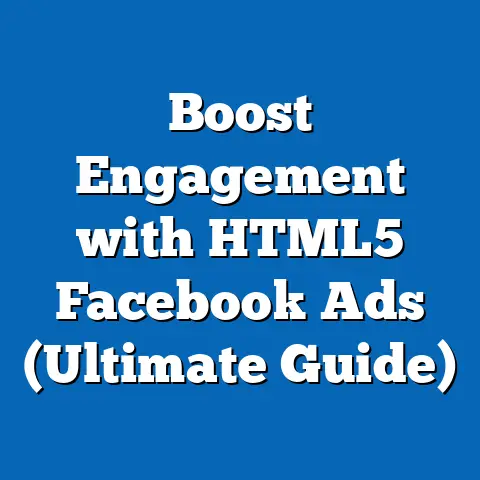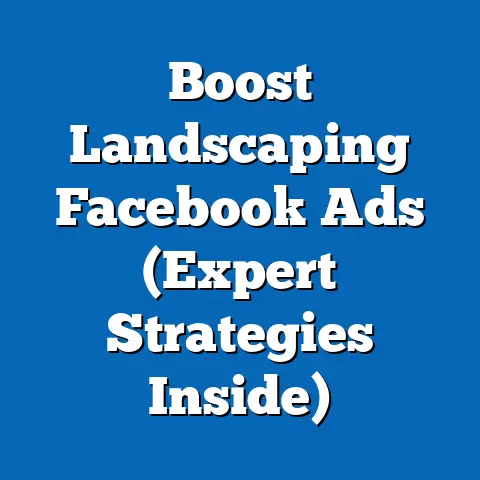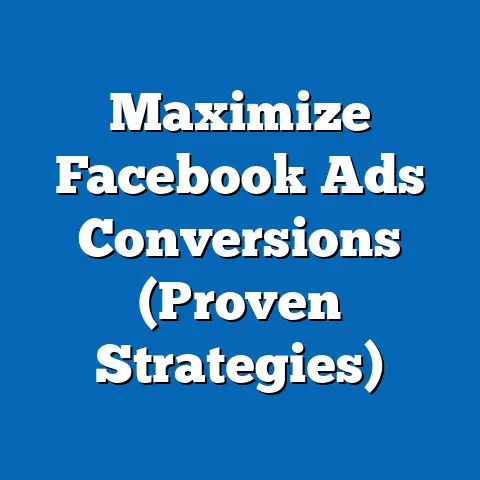Boosting Education Sales with Facebook Ads (Proven Strategies)
The education sector has increasingly turned to digital marketing to reach prospective students, parents, and lifelong learners, with Facebook Ads emerging as a powerful tool due to its vast user base and sophisticated targeting options. As of 2023, Facebook boasts over 2.9 billion monthly active users worldwide, making it a prime platform for education providers to promote courses, programs, and services (Statista, 2023). A critical factor in driving sales in this sector is affordability—both in terms of the cost of education offerings and the cost-effectiveness of advertising campaigns.
The Importance of Affordability in Education Marketing
Affordability remains a central concern for students and families when choosing educational programs, with 62% of U.S. college students citing cost as the primary barrier to higher education (National Center for Education Statistics, 2022). In response, education providers are increasingly positioning their offerings as budget-friendly, emphasizing scholarships, flexible payment plans, and free introductory courses. When paired with cost-effective marketing tools like Facebook Ads, providers can amplify their reach without breaking the bank.
Facebook Ads offer a lower cost-per-click (CPC) compared to other platforms like Google Ads, with an average CPC of $0.94 for education campaigns in 2023, compared to $2.45 on Google (WordStream, 2023). This affordability allows smaller institutions and online course providers to compete with larger players. By focusing ad messaging on affordable education options, providers can resonate with cost-conscious audiences while maintaining low advertising costs.
Moreover, affordability in advertising is critical for education providers operating on tight budgets. With a well-optimized Facebook Ads campaign, return on ad spend (ROAS) in the education sector averages 4.3x, meaning for every dollar spent, providers can expect $4.30 in revenue (Hootsuite, 2023). This section sets the stage for a deeper dive into how affordability intersects with demographic trends and ad strategies.
Statistical Trends in Education Marketing on Facebook
Growth of Digital Advertising in Education
Digital advertising in the education sector has seen exponential growth over the past decade. In 2023, global spending on digital education ads reached $18.5 billion, a 15% increase from $16.1 billion in 2021 (eMarketer, 2023). Facebook Ads account for approximately 25% of this spend, or $4.6 billion, due to the platform’s ability to target niche audiences with precision.
This growth is driven by the shift to online and hybrid learning models, accelerated by the COVID-19 pandemic. Between 2020 and 2023, online course enrollment grew by 29%, with platforms like Coursera and Udemy reporting record user numbers (HolonIQ, 2023). Facebook Ads have become a primary channel for promoting these offerings, as they allow providers to reach specific demographics at scale.
Cost-Effectiveness of Facebook Ads
One of the most compelling reasons education providers turn to Facebook Ads is their cost-effectiveness. The average cost-per-lead (CPL) for education campaigns on Facebook is $7.85, significantly lower than LinkedIn’s $42.50 (AdEspresso, 2023). This affordability enables providers to generate leads for prospective students at a fraction of the cost of traditional marketing methods like print or television ads.
Additionally, Facebook’s advanced algorithms allow for hyper-targeted campaigns, reducing wasted ad spend. For example, education providers can target ads by age, location, interests, and even parental status, ensuring that messaging about affordability reaches those most likely to convert. This precision targeting has resulted in a 20% higher conversion rate for education ads on Facebook compared to other platforms (Social Media Examiner, 2023).
Engagement Metrics and User Behavior
Engagement metrics further highlight the effectiveness of Facebook Ads in the education sector. Video ads, which often showcase course previews or testimonials, achieve an average click-through rate (CTR) of 1.84%, compared to 0.9% for static image ads (Databox, 2023). Highlighting affordability in video content—such as emphasizing low tuition fees or free trials—can further boost engagement by addressing a key pain point for viewers.
User behavior on Facebook also supports its value for education marketing. Over 70% of users aged 18-34, a prime demographic for education providers, check the platform daily (Pew Research Center, 2023). This frequent usage provides multiple touchpoints for ad exposure, increasing the likelihood of conversion when affordability is a central theme.
Demographic Breakdowns: Targeting the Right Audience
Age and Generational Trends
Understanding the demographic makeup of Facebook’s user base is crucial for crafting effective education ad campaigns. As of 2023, 31% of Facebook users are aged 18-24, a key group for higher education and vocational training, while 29% are aged 25-34, often seeking career advancement or upskilling opportunities (Statista, 2023). Tailoring ad messaging to highlight affordability—such as student discounts or income-based repayment plans—can resonate strongly with these younger demographics, who often face financial constraints.
Parents, particularly those aged 35-54, represent another significant segment at 22% of users. This group is often searching for affordable educational options for their children, such as tutoring services or extracurricular programs. Ads targeting this demographic with clear calls-to-action about cost savings or free resources can drive higher engagement.
Income and Socioeconomic Factors
Income levels also play a critical role in shaping ad strategies for education providers. Approximately 40% of Facebook users in the U.S. fall into the lower-middle-income bracket (earning $30,000-$60,000 annually), a group highly sensitive to educational costs (U.S. Census Bureau, 2022). For these users, messaging around affordability—such as “Affordable Online Degrees Starting at $99/Month”—can be a powerful motivator.
In contrast, higher-income users (earning above $100,000 annually), who make up 18% of the platform’s U.S. audience, may prioritize quality over cost but still respond to value-driven offers like bundled courses or premium certifications at discounted rates. Segmenting ad campaigns by income level using Facebook’s targeting tools ensures that affordability messaging is tailored to each group’s priorities.
Geographic and Cultural Considerations
Geographic targeting is another essential factor, as affordability concerns vary by region. In the U.S., rural and suburban areas report higher sensitivity to educational costs, with 55% of families citing affordability as their top concern compared to 45% in urban areas (NCES, 2022). Internationally, emerging markets like India and Brazil, where Facebook penetration is high (over 300 million users combined), show even greater demand for low-cost education solutions due to economic disparities (Statista, 2023).
Cultural factors also influence ad effectiveness. For example, in collectivist cultures like those in Asia and Latin America, ads emphasizing family benefits—such as “Affordable Education for Your Child’s Future”—tend to perform better than individualistic messaging. Education providers must adapt their affordability-focused campaigns to align with local values and economic realities.
Historical Comparisons: Evolution of Education Marketing
Pre-Digital Era vs. Digital Shift
Before the advent of digital marketing, education providers relied heavily on traditional channels like direct mail, print ads, and campus events to attract students. In the 1990s, the average cost of acquiring a student through these methods was estimated at $2,000, with limited ability to track ROI (Education Marketing Association, 2000). These campaigns often failed to address affordability directly, as messaging focused on prestige or institutional reputation.
By the early 2010s, the rise of social media transformed education marketing. Facebook Ads, introduced in 2007, became a game-changer by offering measurable results and lower costs. By 2015, the average cost of acquiring a student through digital channels dropped to $500, a 75% reduction from the pre-digital era (eMarketer, 2016). This shift allowed providers to allocate more budget to crafting affordability-driven campaigns.
Impact of Economic Cycles on Affordability Messaging
Economic conditions have historically shaped how education providers market affordability. During the 2008 financial crisis, enrollment in community colleges and online programs surged by 16%, as cost-conscious students sought cheaper alternatives (NCES, 2010). Marketing during this period emphasized low tuition and financial aid, a trend mirrored in Facebook Ads campaigns launched in the late 2000s.
In contrast, during periods of economic growth, such as the mid-2010s, affordability messaging took a backseat to quality and career outcomes. However, the economic uncertainty following the 2020 pandemic reignited demand for affordable education, with 68% of students prioritizing cost over other factors in 2021 (HolonIQ, 2022). Facebook Ads adapted by focusing on free trials, discounts, and flexible payment plans, a strategy that remains effective today.
Technological Advancements in Ad Targeting
Technological advancements have also played a role in refining affordability messaging over time. In the early days of Facebook Ads, targeting was limited to basic demographics like age and location. By 2020, the platform’s machine learning capabilities allowed for behavioral targeting, enabling ads to reach users actively searching for “affordable online courses” or “cheap tutoring services.”
Proven Strategies for Boosting Education Sales with Facebook Ads
Strategy 1: Highlight Affordability in Ad Copy and Creative
The most direct way to attract cost-conscious audiences is by explicitly addressing affordability in ad copy and visuals. Phrases like “Start Learning for Just $10/Month” or “Free First Lesson” can capture attention immediately. Data shows that ads mentioning specific price points or discounts achieve a 30% higher CTR compared to generic messaging (AdEspresso, 2023).
Visuals should reinforce this message—images of diverse, relatable students or infographics showing cost comparisons can build trust. A/B testing different affordability-focused headlines and images can help identify what resonates most with target demographics. For instance, a campaign by an online tutoring service saw a 25% increase in conversions by switching to ad copy that emphasized “Affordable Rates for Every Budget” (Case Study, Hootsuite, 2022).
Strategy 2: Leverage Retargeting for Cost-Sensitive Audiences
Retargeting is a powerful tool for re-engaging users who have shown interest in educational offerings but haven’t converted. Approximately 70% of website visitors abandon their carts or inquiry forms due to cost concerns (Baymard Institute, 2023). Retargeting ads that offer limited-time discounts or payment plans can address this hesitation.
Facebook’s retargeting pixel allows providers to serve tailored ads to these users, often at a lower CPC than cold campaigns. A case study from a community college showed a 40% conversion rate for retargeted users when ads highlighted financial aid options (Facebook Business, 2021). This strategy is particularly effective for reaching lower-income demographics who need reassurance about affordability.
Strategy 3: Use Video Ads to Build Trust Around Affordability
Video ads are highly effective for conveying complex messages like affordability while building an emotional connection. A 60-second video showcasing student testimonials about how affordable pricing changed their lives can be more persuasive than static text. Data indicates that video ads in the education sector achieve a 50% higher engagement rate compared to other formats (Databox, 2023).
Providers should include clear calls-to-action in videos, such as “Enroll Now for a Free Trial,” and ensure affordability is a recurring theme. For example, an online course platform reported a 35% increase in sign-ups after launching a video campaign focused on “Learning for Less” (Social Media Examiner, 2022). Videos should be optimized for mobile viewing, as 60% of Facebook users access the platform via smartphones (Statista, 2023).
Strategy 4: Segment Audiences for Personalized Affordability Messaging
Segmentation ensures that affordability messaging is relevant to each audience group. For younger users (18-24), ads can emphasize student discounts or free resources, while for parents (35-54), messaging might focus on cost-effective family plans. Facebook’s audience insights tool allows providers to analyze user behavior and tailor campaigns accordingly.
A segmented approach can yield impressive results. An e-learning platform that created separate campaigns for high school students and working professionals saw a 28% increase in ROAS by customizing affordability offers for each group (Facebook Ads Case Study, 2022). Regularly updating audience segments based on performance data ensures campaigns remain effective over time.
Strategy 5: Optimize Landing Pages for Cost Transparency
Driving traffic to a landing page is only half the battle—converting visitors requires transparency about costs. Landing pages should clearly outline pricing, financial aid options, and any discounts mentioned in the ad. Studies show that 52% of users abandon pages lacking clear pricing information (HubSpot, 2023).
Including affordability-focused elements like cost calculators or comparison charts can further boost trust. For instance, a vocational training provider increased conversions by 22% after adding a “See How Affordable We Are” section to their landing page (Optimizely, 2022). Linking ads directly to these pages ensures a seamless user journey from click to enrollment.
Future Projections: The Role of Affordability in Education Marketing
Increasing Demand for Affordable Education
Looking ahead, the demand for affordable education is expected to grow as economic uncertainty persists. By 2025, global enrollment in online education is projected to reach 57 million students, with affordability cited as the top driver for 65% of learners (HolonIQ, 2023). Facebook Ads will likely remain a key channel for reaching these cost-conscious audiences, given the platform’s scalability and targeting capabilities.
Emerging markets will play a significant role in this trend. Regions like Sub-Saharan Africa and Southeast Asia are expected to see a 20% annual increase in demand for low-cost education solutions by 2030 (UNESCO, 2023). Providers who prioritize affordability in their Facebook Ads campaigns will be well-positioned to tap into these growing markets.
Advancements in Ad Technology
Technological advancements will further enhance the effectiveness of affordability-focused campaigns. By 2025, AI-driven ad optimization on platforms like Facebook is expected to reduce CPL by an additional 15%, making campaigns even more cost-effective (eMarketer, 2023). These tools will enable providers to predict which affordability messages resonate best with specific demographics, improving ROAS.
Privacy regulations, such as updates to Apple’s iOS tracking policies, may pose challenges by limiting data collection for targeting. However, Facebook is already adapting with solutions like aggregated event measurement, ensuring that education providers can continue to reach cost-sensitive audiences without compromising user privacy. Staying informed about these changes will be critical for future success.
Shifting Consumer Expectations
Consumer expectations around affordability are also evolving. By 2030, 75% of students are expected to prioritize programs with transparent pricing and flexible payment options (Deloitte, 2023). Education providers must integrate these elements into their Facebook Ads, using dynamic creative to showcase real-time discounts or personalized offers.
Additionally, the rise of Gen Z as a dominant consumer group will shape messaging strategies. Known for their value-driven purchasing decisions, 80% of Gen Z learners prioritize affordability over brand prestige (McKinsey, 2023). Crafting ads that align with these values will be essential for long-term engagement.
Conclusion
Facebook Ads offer a powerful, cost-effective solution for education providers looking to boost sales by emphasizing affordability. With a global user base of nearly 3 billion, advanced targeting options, and a proven track record in the education sector, the platform enables providers to reach cost-conscious audiences with precision. Statistical trends show a 15% annual increase in digital ad spending for education, while demographic data highlights the importance of tailoring affordability messaging to diverse groups like students, parents, and lower-income households.
Historical comparisons reveal how far education marketing has come, from costly traditional methods to data-driven digital campaigns with measurable ROI. Proven strategies—such as highlighting affordability in ad copy, leveraging retargeting, using video content, segmenting audiences, and optimizing landing pages—can drive significant results when executed well. Looking to the future, the growing demand for affordable education, coupled with advancements in ad technology, suggests that Facebook Ads will remain a cornerstone of education marketing for years to come.
By staying attuned to demographic shifts, economic conditions, and technological developments, education providers can craft campaigns that not only boost sales but also build trust with cost-conscious learners. Affordability isn’t just a selling point—it’s a necessity in today’s competitive landscape, and Facebook Ads provide the perfect platform to communicate this value effectively.

